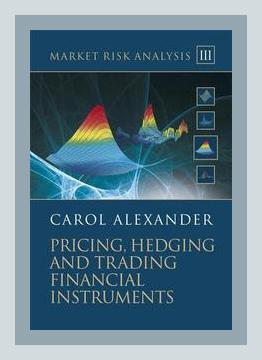Finance, Economics, Trading, InvestingQuantitative Finance and Risk Management
Introduction
“Market Risk Analysis Volume II: Practical Financial Econometrics” by Carol Alexander is a comprehensive guide for financial professionals and academics who seek to understand the advanced techniques of financial econometrics in the context of market risk analysis. The book delves into the quantitative methods required to model financial markets, providing the tools necessary to manage market risk effectively. With a clear focus on practical application, Carol Alexander bridges the gap between theoretical econometrics and its real-world usage in financial markets. This volume stands out for its methodical approach, making complex concepts accessible without sacrificing depth.
Section 1: Overview of Financial Econometrics
Carol Alexander begins by introducing the foundational concepts of financial econometrics, setting the stage for the more advanced topics discussed later in the book. The initial chapters cover the importance of econometrics in financial markets, explaining how these methods are used to analyze market data, forecast future trends, and assess risk. One of the key themes here is the emphasis on understanding the stochastic processes that drive market behavior.
Example 1: Time Series Analysis
The book introduces time series analysis as a critical tool for understanding market data. Alexander provides a detailed explanation of how financial time series differ from other types of data, focusing on the unique challenges they present, such as volatility clustering and non-stationarity.
Memorable Quote 1:
“Financial time series are not just data points strung together over time; they are the heartbeat of market dynamics, reflecting every pulse of investor sentiment and economic change.”
This quote encapsulates the essence of why time series analysis is so crucial in financial econometrics.
Section 2: Modeling Volatility
A significant portion of “Market Risk Analysis Volume II” is dedicated to the modeling of volatility, a central aspect of financial econometrics. Alexander explores various models, including the Autoregressive Conditional Heteroskedasticity (ARCH) and Generalized ARCH (GARCH) models, which are instrumental in capturing the changing volatility of financial returns.
Example 2: GARCH Models in Practice
Alexander not only explains the theoretical underpinnings of GARCH models but also demonstrates their application in real-world scenarios. For instance, she discusses how these models are used to forecast volatility in stock markets, helping risk managers anticipate periods of high risk.
Memorable Quote 2:
“Volatility is the lifeblood of financial markets, constantly shifting and evolving, much like the markets themselves. Capturing its essence is key to mastering market risk.”
This quote highlights the dynamic nature of volatility and its significance in financial markets.
Section 3: Multivariate Models and Risk Management
In this section, Alexander transitions to multivariate models, which are essential for understanding the relationships between multiple financial variables. The book covers the intricacies of modeling the joint behavior of asset returns, emphasizing the importance of correlation and copula models in risk management.
Example 3: Copula Models
The author provides a detailed discussion on copula models, illustrating how they allow risk managers to model the dependency structure between different financial assets. This is crucial for portfolio risk management, as it enables a more accurate assessment of the risk of extreme events.
Memorable Quote 3:
“Understanding the interconnectedness of financial markets is like deciphering a complex web; each strand influences the others, and the strength of those connections can mean the difference between profit and loss.”
This quote underscores the complexity of financial markets and the importance of multivariate models in managing market risk.
Section 4: Forecasting and Model Evaluation
Forecasting future market conditions is a critical component of market risk analysis. Carol Alexander dedicates a significant portion of the book to discussing various forecasting methods, including both linear and nonlinear models. She emphasizes the importance of model evaluation, providing readers with tools to assess the accuracy and reliability of their forecasts.
Example 4: Model Evaluation Techniques
Alexander introduces techniques such as out-of-sample testing and backtesting, which are essential for validating the performance of financial models. She provides practical examples of how these techniques are applied in real-world scenarios, ensuring that readers can implement them in their own work.
Section 5: Practical Applications and Case Studies
The final section of the book focuses on the practical applications of the econometric methods discussed throughout the volume. Alexander includes several case studies that demonstrate how these techniques are used in the real world to manage market risk. These case studies cover a range of topics, from portfolio optimization to risk management in derivative markets.
Example 5: Case Study on Portfolio Optimization
One of the standout case studies in this section involves portfolio optimization, where Alexander illustrates how econometric models can be used to construct portfolios that balance risk and return. She provides a step-by-step guide to the process, making it accessible to readers who may be new to the concept.
Conclusion
“Market Risk Analysis Volume II: Practical Financial Econometrics” by Carol Alexander is an essential resource for anyone involved in financial markets, whether they are academics, practitioners, or students. The book’s thorough exploration of econometric methods, combined with practical applications and real-world examples, makes it an invaluable tool for managing market risk. Carol Alexander’s ability to make complex topics accessible without oversimplifying them ensures that this volume will remain a key reference in the field of financial econometrics.
This book not only equips readers with the knowledge to model and manage market risk but also challenges them to think critically about the limitations and assumptions of the models they use. In an era where financial markets are becoming increasingly complex, “Market Risk Analysis Volume II” provides the necessary tools to navigate these challenges effectively.
Finance, Economics, Trading, InvestingQuantitative Finance and Risk Management
